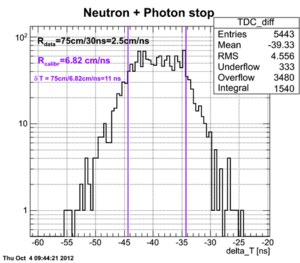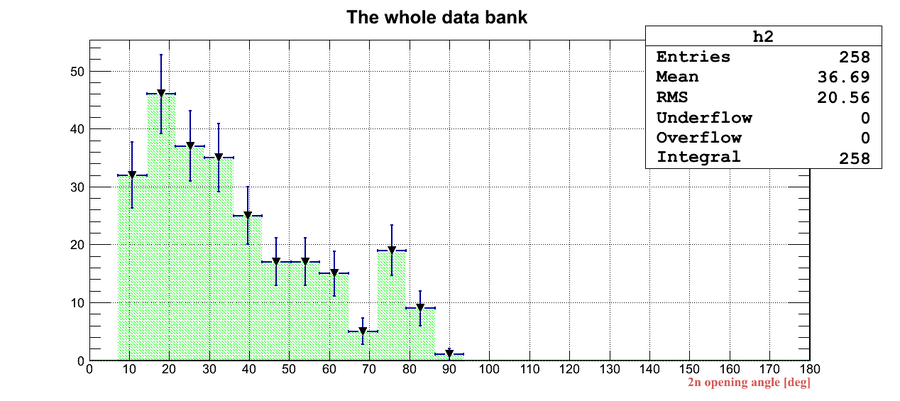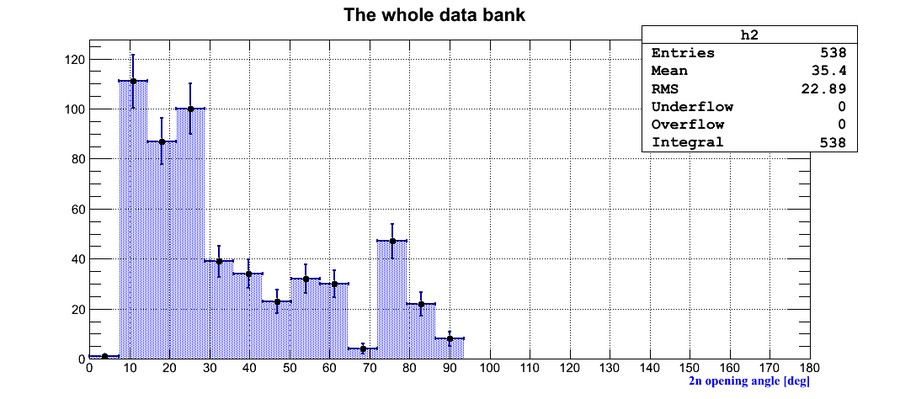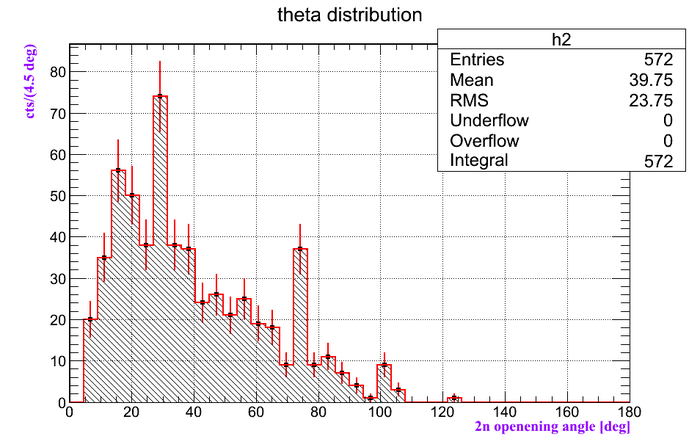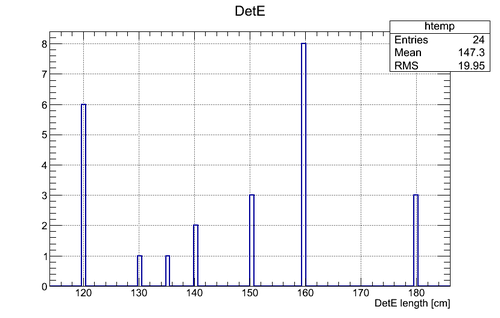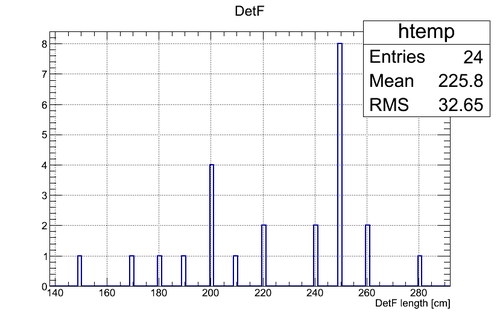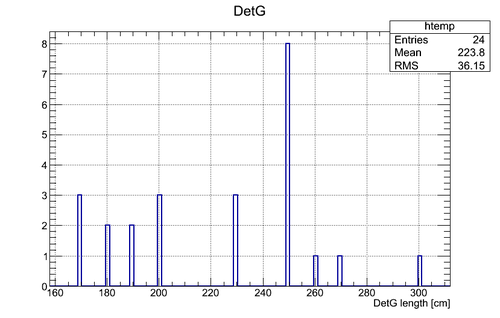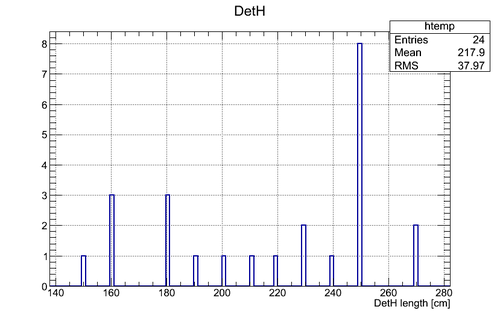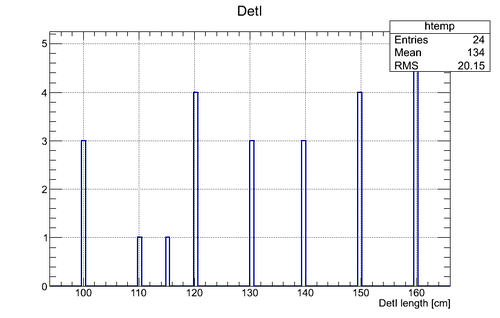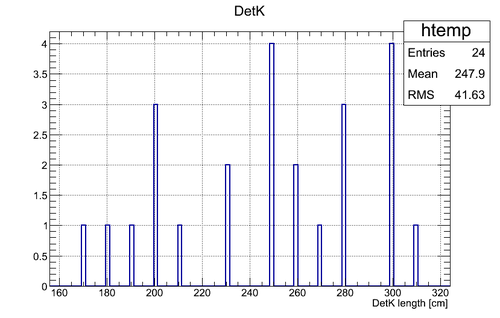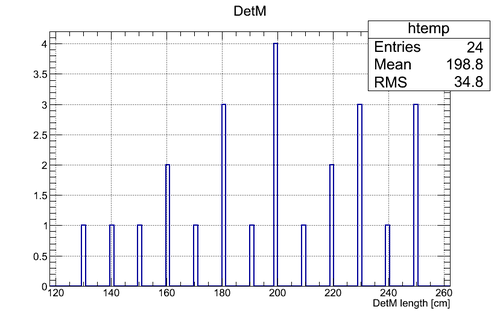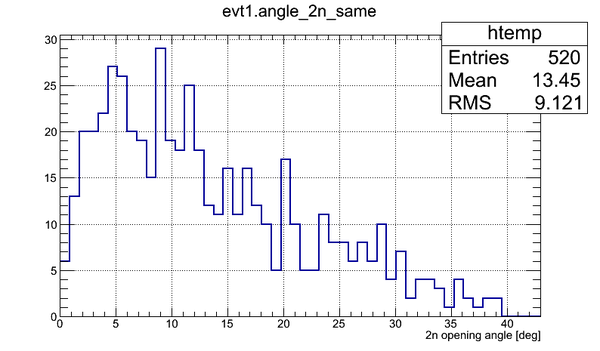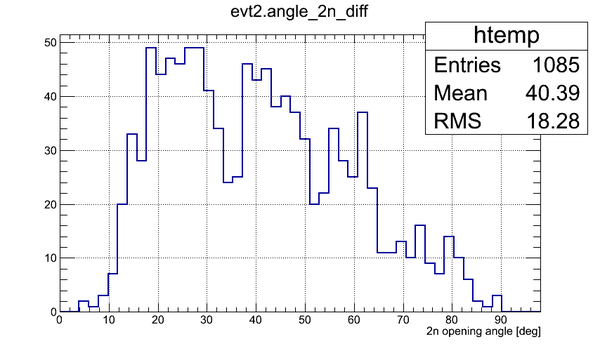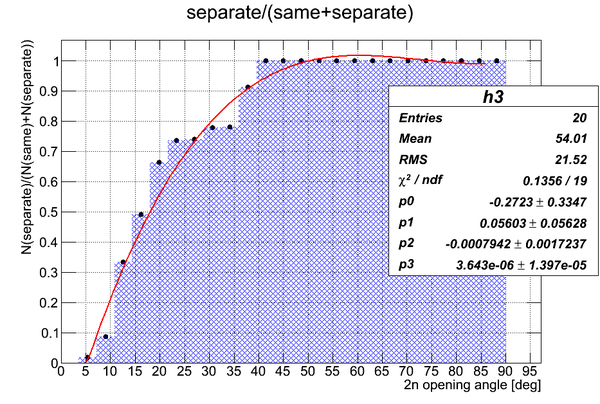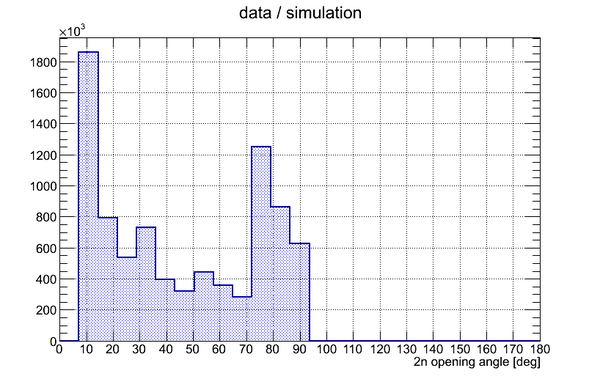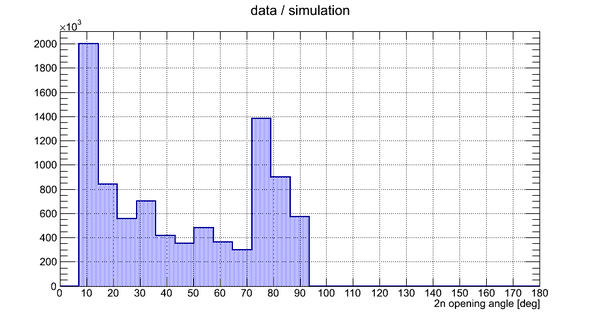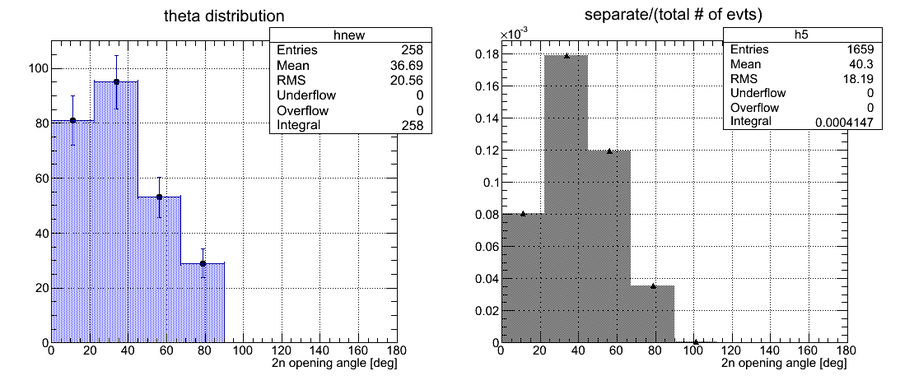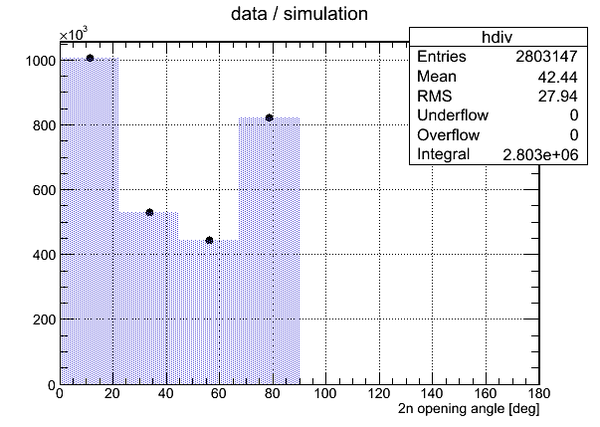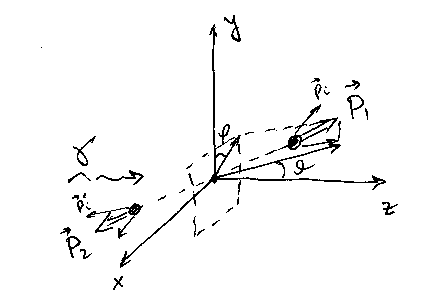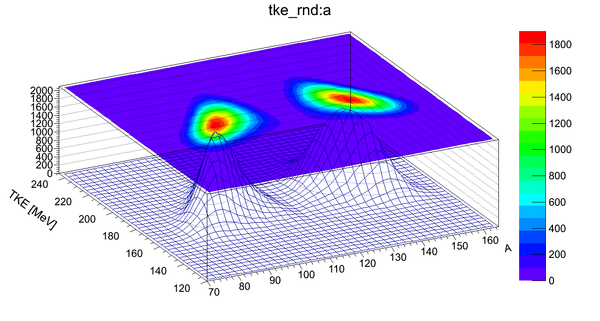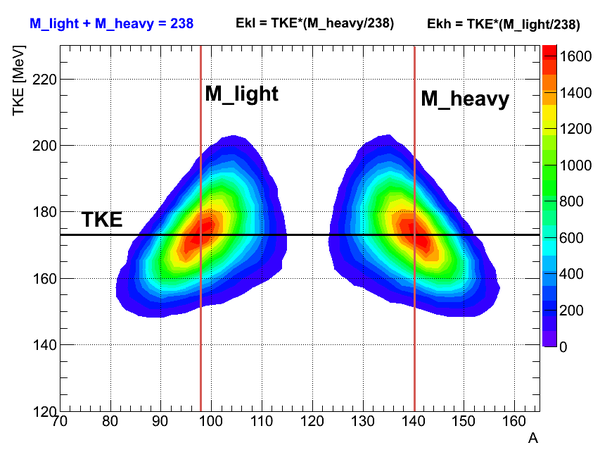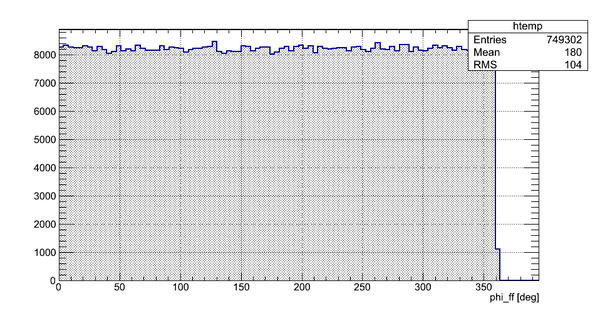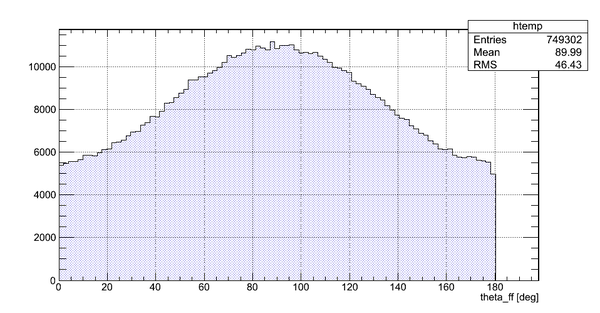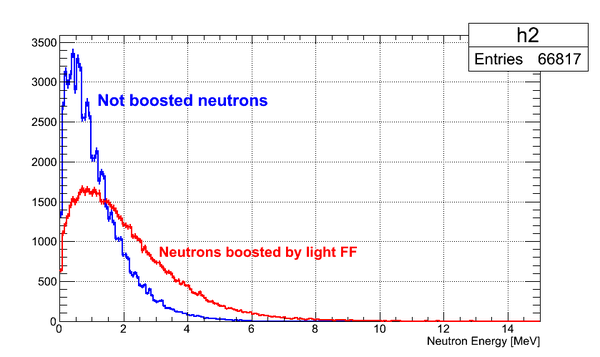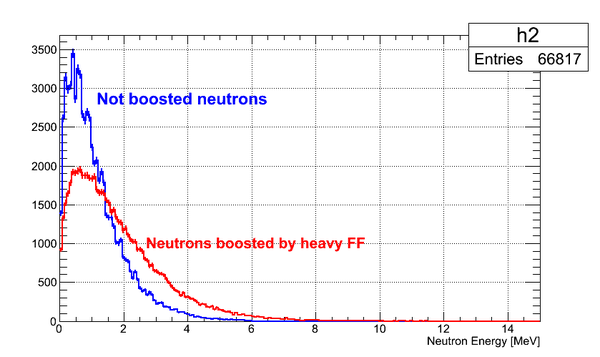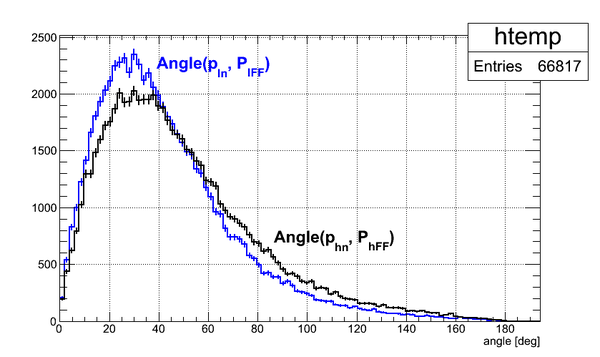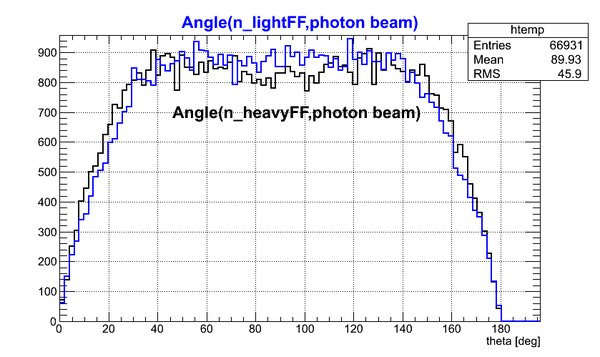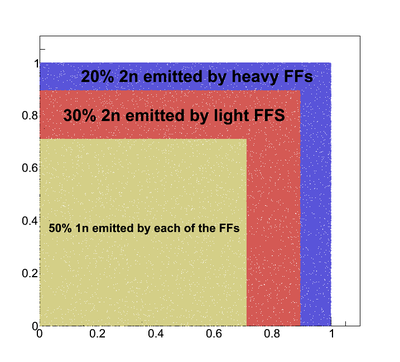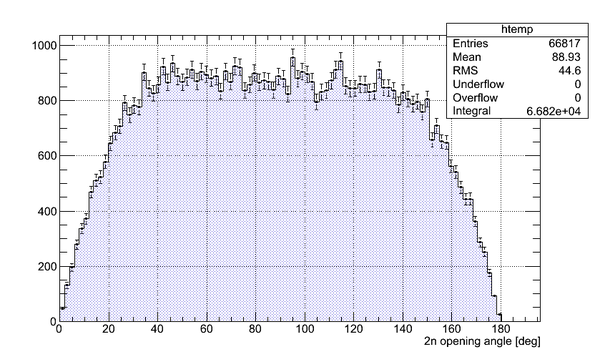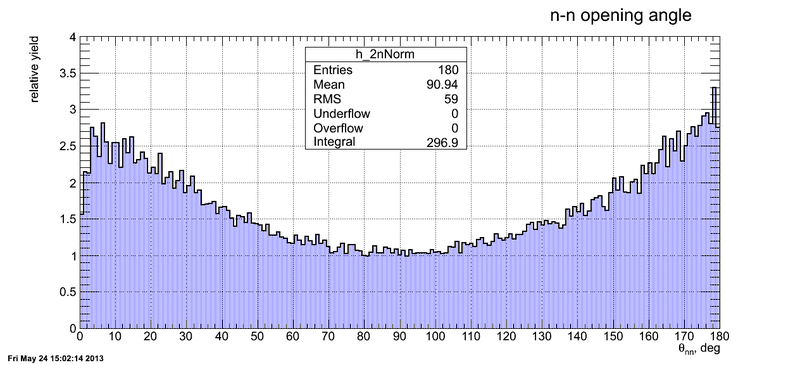Difference between revisions of "2n opening angle"
| (53 intermediate revisions by the same user not shown) | |||
| Line 127: | Line 127: | ||
==2n angle by Monte Carlo== | ==2n angle by Monte Carlo== | ||
| − | + | The photofission lab frame is plotted below. Photon is coming along z-axis. Two fission fragments (heavy and light) created with the corresponding total momentum <math>\vec P_1</math> and <math>\vec P_2</math>. Each fission fragment emits one neutron each per fission event. | |
| − | [[File: | + | [[File:geometry_2nfissiom_model.png || 450px]] |
| + | Momentum of each FF in the lab frame can be described as | ||
| − | + | <math>P_x^{ff} = \sqrt{E_{ff}^2-m_{ff}^2}\cdot sin(\theta)cos(\phi)</math> | |
| + | <math>P_y^{ff} = \sqrt{E_{ff}^2-m_{ff}^2}\cdot sin(\theta)sin(\phi)</math> | ||
| − | + | <math>P_z^{ff} = \sqrt{E_{ff}^2-m_{ff}^2}\cdot cos(\theta)</math> | |
| + | Here <math>E_{ff}</math> and <math>m_{ff}</math> is the total energy and mass of heavy /light FF. Heavy and light FFs are emitted at 180 degrees w.r.t. each other. | ||
| − | + | Neutron energy spectrum in the FF rest frame was taken as | |
| + | <math>N(E_n)=\sqrt{E_n}\cdot e^{\frac{-E_n}{0.75}}</math> | ||
| − | + | and neutron angular distribution in the FF rest frame was isotropic. Momentum of the neutrons was calculated as follows | |
| + | <math>P_x^{n} = \sqrt{E_{n}^2-m_{n}^2}\cdot sin(\theta')cos(\phi')</math> | ||
| − | + | <math>P_y^{n} = \sqrt{E_{n}^2-m_{n}^2}\cdot sin(\theta')sin(\phi')</math> | |
| + | <math>P_z^{n} = \sqrt{E_{n}^2-m_{n}^2}\cdot cos(\theta')</math> | ||
| + | |||
| + | Momenta of the neutrons emitted by light FFs were uncorrelated with the momenta of the neutrons emitted by heavy FFs. | ||
| + | |||
| + | |||
| + | Mass dependence of fission fragments and their total kinetic energy (TKE): | ||
| + | |||
| + | [[File:mass_vs_ebergyff_surf.png || 600px]] | ||
| + | |||
| + | |||
| + | [[File:mass_vs_ebergyff_cont.png || 600px]] | ||
| + | |||
| + | |||
| + | Angular distribution of the FF in the lab frame W(Theta) = a+b*(Sin(Theta))^2. Photon beam is not polarized hence there is no azimuthal anizotropy. | ||
| + | |||
| + | |||
| + | [[File:phi_distr_ff1.png || 600px]] | ||
| + | |||
| + | |||
| + | [[File:theta_distr_ff1.png || 600px]] | ||
| + | |||
| + | |||
| + | Energy of the neutron emitted in the rest frame of the light FF and boosted in the lab frame is shown below. Boost vector is Lorentz 4-vector of the light FF. | ||
| + | |||
| + | [[File:light_ff_Enboost_improved2.png || 600px]] | ||
| + | |||
| + | Energy of the neutron emitted in the rest frame of the heavy FF and boosted in the lab frame is shown below. Boost vector is Lorentz 4-vector of the heavy FF. | ||
| + | |||
| + | [[File:heavy_ff_Enboost_improved.png || 600px]] | ||
| + | |||
| + | As can be seen from the plots representing boosted energy of the neutrons, the energy of the neutron emitted by light FF boosted to the higher values than the energy of the neutron emitted by heavy FF because the energy of heavy FF is lower than the energy of light FF. | ||
| + | |||
| + | The angle between boosted neutron momentum and FF momentum is plotted below for both hevy FFs and light FFs | ||
| + | |||
| + | [[File:angle_nhff_nlff2.png || 600px]] | ||
| + | |||
| + | |||
| + | The angle between boosted neutron momentum and photon beam (z-axis) is plotted for neutrons emitted by heavy FFs and by light FFs. | ||
[[File:angle_nhff_nlff_photonBeam.png || 600px]] | [[File:angle_nhff_nlff_photonBeam.png || 600px]] | ||
| + | Next we considered the multiplicity of the neutrons emitted by each of the FF and got the following results. The neutron multiplicity for each fission event was equal 2.0 . | ||
| + | |||
| + | |||
| + | For the neutron multiplicity distributed between FFs in the following proprtion | ||
| + | |||
| + | [[File:n_multiplicity_50_30_20.png || 400px]] | ||
| + | |||
| + | We got the 2n opening angle is either the angle between the momentum of the neutron <math>\vec p_{ln}</math> emitted by light FF and the momentum of the neutron <math>\vec p_{hn}</math> emitted by hevy FF or the angle between the momenta of the neutrons emitted by light or heavy FFs (according to the multiplicity). | ||
| + | |||
| + | [[File:2n_angle_LalNl_corrected.png || 600px]] | ||
| + | |||
| + | After phase space effect removal we got the following 2n opening angle: | ||
| − | [[File: | + | [[File:2n_angle_LalNl_NOphaseSpace.png || 800px]] |
Latest revision as of 22:03, 24 May 2013
Experimental data
2n opening angle spectra obtained after the processing of all the runs with thick uranium target are shown below for the tow cases (a) with coordinate cuts implied by the calibration with independent Co-60 source and (b) without the cuts applied and self calibration used:
Experimental data with coordinate cuts applied
Coordinate cuts were applied but the length of the active area was fixed to 75 cm (the actual length of the active area of the neutron detector)
The bin width (x-error) is 7.2 degrees, the total number of bins is 25. Statistical error (y-error) is presented for each bin.
At this stage there is no efficiency normalization involved in the calculation. The main goal is to show that we've got 258 neutrons in all the runs.
Experimental data without coordinate cuts applied I
A. Coordinate cuts were NOT applied.
B. Self calibration was used assuming the length of the active area was fixed to 75 cm (the actual length of the active area of the neutron detector)
Experimental data without coordinate cuts applied II
A. Coordinate cuts were NOT applied. "Whole" region of the neutron hit coordinates was used.
B. Co-60 source calibration was used. The active area length of the neutron detectors was varied according to the neutron hit coordinate distribution and the calibration factor obtained with Co-60 source.
Below the spectra of the neutron detectors effective length is represented after using calibration obtained in a separate experiment with Co-60 source and NO coordinate cuts applied. The actual detector active area lenfth is 75 cm.
Simulation
GEANT4 was used to sample two neutrons isotropically, to track them and opening angle was observed for two cases when (1) two neutrons hit the same detector (N(same)) and (2) two neutrons hit two different detectors (N(different)). After that the plot of N(different)/(N(same)+N(different)) was made.
The total number of neutron pairs sampled was , emission of neutrons was in form isotropic point source. Geometry of the experiment was preserved.
The 2n opening angle for the case (1) is shown below:
The 2n opening angle for the case (2) is shown below:
It can be seen that the probability to hit two different detectors about twice larger than the probability to hit the same detector for the isotropic point source of neutrons.
The plot of N(different)/(N(same)+N(different)):
Hence, (A) in the experimental data we can not see neutron pairs with the opening angle less then ~5 degrees because they all are multi-hit data, (B) multi-hit data disappear at 2n opening angle above 40 degrees.
Correction of experimental data for the geometry
As it was shown above we could not detect multiple hits of the same detector. In order to obtain the influence of the geometry on the data we will consider 2n opening angle for neutrons hitting two different detectors.
Comparison of the data and 2n opening angle obtained via simulation is shown below. The histograms have same number of bins (25) and same bin width (7.2).
The plot on the right was normalized to the total number of neutron pairs sampled during the simulation.
The result of division of experimental data histogram by the normalized simulation data histogram is shown below:
Statistics over the last three bins
The number of neutron pairs sampled was increased up to 4E+6. The simulated data (see figure below) have pretty much the same trend as it was presented above for 2.5E+6 sampled neutrons.
The last three bins were chosen to do statistical analysis. The data are shown below in the table.
| Bin center(full width) [deg] | Experiment [cnts+/-sqrt(cnts)] | Simulation [cnts+/-sqrt(cnts)] | Normzd simulation | Experiment/(Normlzd simulation) |
|---|---|---|---|---|
| 75.6(7.2) | 19.0 +/- 4.4 | 55.0 +/- 7.4 | (1.4 +/- 0.2)E-5 | 13.82E+5 +/- 27% |
| 82.8(7.2) | 9.0 +/- 3.0 | 40.0 +/- 6.3 | (1.0 +/- 0.2)E-5 | 9.0E+5 +/- 39% |
| 90(7.2) | 1.0 +/- 1.0 | 7.0 +/- 2.6 | (0.17 +/- 0.06)E-5 | 5.8E+5 +/- 100% |
As can be seen the last bin in the experimental data has only one count. So it is hard to do a certain conclusion about the precision of the measurement for the last bin. The errors are a bit smaller for the two following bins. It is possible to decrease the number of bins, however, the angular resolution will be decreased either. Currently the bin width is 7.2 degree.
Reduced number of bins
After the number of bins was reduced the experimental data (left) and normalized simulation data (right) look like this:
Now the bin width is 22.5 degrees.
The plot of the experimental data divided by the normalized simulation data is shown below:
There is still increase of event number in the 2n opening angle spectrum in the bin# 4. Statistics on the 4th bin is presented below in the table.
| Bin center(full width) [deg] | Experiment [cnts+/-sqrt(cnts)] | Simulation [cnts+/-sqrt(cnts)] | Normzd simulation | Experiment/(Normlzd simulation) |
|---|---|---|---|---|
| 78.75(22.5) | 29.0 +/- 5.4 | 141.0 +/- 11.9 | (35.25 +/- 2.97)E-6 | 82E+4 +/- 20% |
2n angle by Monte Carlo
The photofission lab frame is plotted below. Photon is coming along z-axis. Two fission fragments (heavy and light) created with the corresponding total momentum and . Each fission fragment emits one neutron each per fission event.
Momentum of each FF in the lab frame can be described as
Here and is the total energy and mass of heavy /light FF. Heavy and light FFs are emitted at 180 degrees w.r.t. each other.
Neutron energy spectrum in the FF rest frame was taken as
and neutron angular distribution in the FF rest frame was isotropic. Momentum of the neutrons was calculated as follows
Momenta of the neutrons emitted by light FFs were uncorrelated with the momenta of the neutrons emitted by heavy FFs.
Mass dependence of fission fragments and their total kinetic energy (TKE):
Angular distribution of the FF in the lab frame W(Theta) = a+b*(Sin(Theta))^2. Photon beam is not polarized hence there is no azimuthal anizotropy.
Energy of the neutron emitted in the rest frame of the light FF and boosted in the lab frame is shown below. Boost vector is Lorentz 4-vector of the light FF.
Energy of the neutron emitted in the rest frame of the heavy FF and boosted in the lab frame is shown below. Boost vector is Lorentz 4-vector of the heavy FF.
As can be seen from the plots representing boosted energy of the neutrons, the energy of the neutron emitted by light FF boosted to the higher values than the energy of the neutron emitted by heavy FF because the energy of heavy FF is lower than the energy of light FF.
The angle between boosted neutron momentum and FF momentum is plotted below for both hevy FFs and light FFs
The angle between boosted neutron momentum and photon beam (z-axis) is plotted for neutrons emitted by heavy FFs and by light FFs.
Next we considered the multiplicity of the neutrons emitted by each of the FF and got the following results. The neutron multiplicity for each fission event was equal 2.0 .
For the neutron multiplicity distributed between FFs in the following proprtion
We got the 2n opening angle is either the angle between the momentum of the neutron emitted by light FF and the momentum of the neutron emitted by hevy FF or the angle between the momenta of the neutrons emitted by light or heavy FFs (according to the multiplicity).
After phase space effect removal we got the following 2n opening angle:
